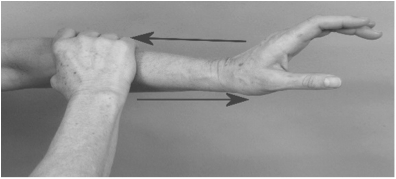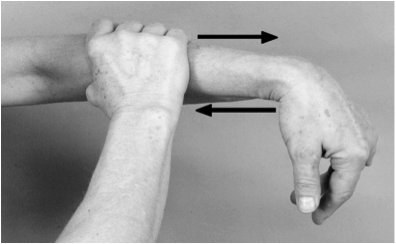Wrist Pain Relief and Eliminate Hand Numbness without Surgery or Medication.
You don’t need to massage your wrist, take pain pills or other medications, and you may not need surgery. To eliminate severe wrist and hand pain simply to release the tension the muscles are placing on the bones.
The Julstro™ System shows you how to self-treat wrist and hand pain by releasing spasms and lengthening muscle fibers. You can relieve hand/wrist pain and numbness, the symptoms of Carpal Tunnel Syndrome—and prevent their return.
What Causes Hand Numbness and Severe Wrist Pain
Muscles are like pulleys. For a joint to move, one muscle group has to contract (shorten) and the opposite muscle group must lengthen.
An understanding of how your arm muscles control the movement of your wrist and hand will be helpful to explain why you are experiencing pain.
Your extensor muscles form the top of your forearm. The muscles merge into tendons at the slender portion of your forearm. The tendons cross over your wrist, attaching to the top of your hand and your fingertips. Your extensor muscles pull your hand up (see picture).

To move your hand up (extension) the extensor muscles on the top of your forearm arm must contract. At the same time, the flexor muscles on the underside of your forearm must relax and lengthen.
Your flexor muscles form the underside of your forearm. They merge into tendons and go through your wrist at your carpal tunnel. Your flexors insert onto the heel of your hand (your carpal bones) and the tips of your fingers. These muscles bring your hand down (see picture) and also curl your hand into a fist.
How Your Wrist and Hand Move
To move your hand down (flexion) the flexor muscles contract and the extensors relax and lengthen.
Since both the flexors and extensors insert into your fingertips, when they are in spasm they are the cause of trigger finger. Also, since the tendons of the flexor muscles go through your carpal tunnel, when the muscle is shortened by spasms it may put pressure on your median nerve as it passes through your carpal tunnel and causes the symptoms of carpal tunnel syndrome.

To feel your forearm muscles work while moving your hand and fingers, firmly grip your right forearm with your left hand (as shown above and to the right) and then move your right hand up and down:
- Make a fist.
- Open your hand and move your fingers.
- Bend your wrist up and down.
For your hand to remain in a neutral (hand hanging down but without any pulling done by the muscles) position, both the extensors and flexors must be relaxed. If either muscle is in spasm it remains shortened by the knot, causing that muscle to pull on the insertion point at the wrist or hand. This is the most common cause of severe wrist pain.
You will feel the muscles contract on one side to pull your hand in that direction, and relax/stretch on the other side to allow the movement. Now, visualize what happens if the relaxing muscle is shortened by a spasm, restricting it so it doesn’t lengthen— your wrist stays still.
Plus, as the muscles are pulling on the bones, you’ll feel pain when you try to move in the opposite direction.
That’s it! There’s no more waiting for a therapist or doctor’s appointment to relieve wrist pain.
You are your best therapist! With the Julstro™ Basic Self-Treatment Kit, you may never need to spend another dollar on expensive therapy or questionable treatments. Our clinical experience with the Julstro™ technique shows a 97% success rate.
- Could muscles really be causing your wrist and hand problems? YES!
- Can you really learn how to do the treatments to yourself? YES!
You don’t need to be strong, you just need to watch Julie as she demonstrates the Julstro™ techniques.
What People Are Saying About Julstro’s Wrist Pain Relief Products


